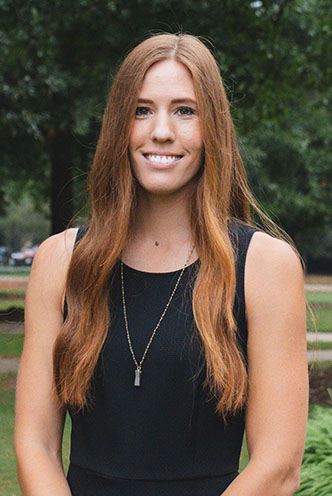
Biography
Dr. Holly Kinder received her BS (2012) in Animal Science and her PhD (2017) in Neuroscience from the University of Georgia (UGA). She has continued her work at UGA as a non-tenure track faculty member in the Department of Animal and Dairy Science. Her research focus is in the area of regenerative bioscience with an emphasis in stem cell therapies for traumatic brain injury (TBI) and stroke. TBI and stroke are leading causes of death and disability in the United States. However, there are currently no Food and Drug Administration (FDA)-approved therapies that promote healing and restore lost function after neural injury. Neural injuries often lead to functional impairments that can significantly disrupt quality of life, therefore her research aims to understand how neural injuries may affect cognition, behavior, and motor function. In addition, she is in interested in unraveling the complex mechanisms of neural injury to identify potential treatment targets. Dr. Kinder’s work has led to a number of important breakthroughs that have been presented at national and international conferences and published in top tier journals (selected publications below).
In her teaching, Dr. Kinder has been a strong advocate for interactive and experiential learning that encourages and engages students to be analytical problem solvers. Her courses have focused on helping students read and understand primary scientific literature and as part of her classes, student learn important professional skills that span well beyond science including writing and presentation skills, critical, and abstract thinking.
Courses Taught:
ADSC
2020: Animals in Society
ADSC 2520: Animal Welfare
ADSC 4520/6520: Animal Cognition and Behavior
RBIO
2010: Introductory Regenerative Bioscience
RBIO 3310: Therapies for Tissue Repair and Regeneration
RBIO
4950: Senior Capstone in Regenerative Bioscience
RBIO 4960/4970/4980/4990: Undergraduate Research
Selected Publications:
Baker, E.W, Kinder, H.A., West, F.D., (2019). Neural Stem Cell Therapy for Stroke: A Multi-Mechanistic Approach to Restoring Neurological Function. BRAIN AND BEHAVIOR, 2019;e01214. doi: 10.1002/brb3.1214
Baker, E. W., Kinder, H. A., Hutcheson, J. M., Duberstein, K. J. J., Platt, S. R., Howerth, E. W., & West, F. D. (2018). Controlled Cortical Impact Severity Results in Graded Cellular, Tissue, and Functional Responses in a Piglet Traumatic Brain Injury Model. JOURNAL OF NEUROTRAUMA, 36(1), 61-73. doi: 10.1089/neu.2017.5551
Kinder, H. A., Baker, E. W., & West, F. D. (2018). The pig as a preclinical traumatic brain injury model: current models, functional outcome measures, and translational detection strategies. NEURAL REGENERATION RESEARCH, 14(3), 413-424. doi:10.4103/1673-5374.245334
Baker, E. W., Henderson, W. M., Kinder, H. A., Hutcheson, J. M., Platt, S. R., & West, F. D. (2018). Scaled traumatic brain injury results in unique metabolomic signatures between gray matter, white matter, and serum in a piglet model. PLOS ONE, 13(10), 21 pages. doi:10.1371/journal.pone.0206481
Baker, E. W., Platt, S. R., Lau, V. W., Grace, H. E., Holmes, S. P., Wang, L., Duberstein, K.J., Howerth, E.W., Kinder, H.A., Stice, S.L., Hess, D.C., Mao, H., West, F. D. (2017). Induced Pluripotent Stem Cell-Derived Neural Stem Cell Therapy Enhances Recovery in an Ischemic Stroke Pig Model. SCIENTIFIC REPORTS, 7, 15 pages. doi:10.1038/s41598-017-10406-x
Platt, S. R., Holmes, S. P., Howerth, E. W., Duberstein, K. J. J., Dove, C. R., Kinder, H. A., Wyatt, E.L., Linville, A.V., Stice, S.L., Hill, W.D., Hess, D.C., West, F. D. (2014). Development and characterization of a Yucatan miniature biomedical pig permanent middle cerebral artery occlusion stroke model. Experimental & translational stroke medicine, 6(1), 5. doi:10.1186/2040-7378-6-5
Yu, P., Lu, Y., Jordan, B.J., Liu, Y., Yang, J., Hutcheson, J.M., Ethridge, C.L., Mumaw, J.L., Kinder, H.A., Beckstead, R.B., Stice, S.L., West, F.D. (2014). Nonviral Minicircle Generation of Induced Pluripotent Stem Cells Compatible with Production of Chimeric Chickens. CELLULAR REPROGRAMMING, 16(5), 366-378. doi: 10.1089/cell.2014.0028
